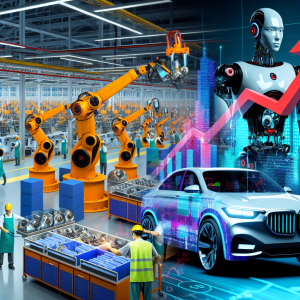The Future of Mechanical Mobility: Why Auto Parts Suppliers Are Poised for a Humanoid Robot Boom
As the world accelerates into an era defined by mechanical mobility—whether on wheels or robotic legs—auto parts suppliers are uniquely positioned to capitalize on a transformative wave that few investors are fully grasping yet. Morgan Stanley’s recent June report, led by autos analyst Adam Jonas alongside industrial and hardware technology experts Sheng Zhong and Andy Meng, reveals a compelling narrative: humanoid robots could spark the next major growth surge for auto parts suppliers, akin to the boosts seen with electric and smart cars.
Here’s the big picture: Just as electric vehicles (EVs) reshaped demand for specialized components, and driver-assist technologies created new markets for smart parts, humanoid robots represent a third frontier. Tesla and Xpeng are already developing humanoids, and others like Zeekr and Volkswagen are experimenting with these robots in factory settings. If you think about it, the skills and technologies that make auto parts suppliers indispensable to EVs and smart cars—precision actuators, joints, and mechanical modules—are directly transferable to humanoid robotics.
Morgan Stanley estimates that auto parts suppliers could capture an astonishing 47% to 60% of the spending on parts and materials for humanoids. To put that in perspective, each humanoid robot might carry about $15,000 worth of parts from these suppliers, making them a critical piece of the humanoid ecosystem. This is not just speculation; it’s a forecast backed by data projecting the humanoid market to reach $5 trillion globally by 2050, with China alone commanding $800 billion.
What does this mean for investors and advisors?
-
Focus on Tier-1 Module Assemblers: Morgan Stanley’s analysts emphasize that tier-1 suppliers—those who assemble key modules—are best positioned to secure orders regardless of which technological pathways humanoid development takes. This contrasts with tier-2 suppliers like lidar or chip producers, whose fate depends heavily on specific tech choices.
-
Watch Key Players Like Sanhua, Tuopu, and Xusheng: These mainland Chinese companies are leading the charge. Sanhua, recently upgraded to overweight, is expanding production to Thailand to mitigate geopolitical risks—a smart move considering ongoing U.S.-China tensions that could disrupt supply chains. Tuopu, despite a slight price target trim due to softer Tesla orders, remains a strong buy given its expertise in actuators—the "muscles" of humanoids. Xusheng, with its structural parts for humanoids, is expected to see revenue recovery as electric vehicle adoption grows.
-
Consider Geopolitical and Supply Chain Risks: While Chinese suppliers hold a cost advantage, geopolitical tensions could force companies to seek pricier alternatives, impacting margins and timelines. Diversification and geographic expansion, like Sanhua’s Thailand plant, will be critical strategies to watch.
- Invest in Growth Sectors with Recurring Demand: Actuators alone are projected to grow their addressable market by 57% annually through 2030. This rapid expansion signals sustained demand, not a fleeting trend.
A Unique Insight:
While Morgan Stanley’s report focuses on Chinese suppliers, investors should also keep an eye on emerging players in other regions that could benefit from the humanoid wave. For example, Japan’s robotics sector, long a pioneer in humanoid tech, is increasingly collaborating with automotive giants to integrate mobility solutions. Diversifying exposure across geographies could hedge against geopolitical risks while tapping into global innovation hubs.
Actionable Advice for Investors and Advisors:
- Reassess Portfolios: Auto parts suppliers are no longer just about cars. Investors should evaluate holdings in these companies with an eye on their robotics potential.
- Monitor Technological Developments: Stay informed on humanoid robotics progress, especially from automakers like Tesla and Xpeng, as their success will drive supplier demand.
- Evaluate Supply Chain Strategies: Companies expanding manufacturing beyond China may offer safer long-term value.
- Consider Thematic ETFs or Funds: Look for funds focusing on robotics, automation, and advanced manufacturing to gain diversified exposure to this trend.
What’s Next?
The humanoid robotics market is still in its infancy but poised for explosive growth. Over the next decade, expect advancements in actuator technology and modular assembly to accelerate. Investors who position themselves early in tier-1 suppliers with strong geopolitical strategies will likely reap significant rewards. As humanoid robots move from factories to everyday life—assisting in healthcare, logistics, and even consumer tasks—the demand for specialized mechanical parts will surge.
In conclusion, the intersection of automotive expertise and humanoid robotics is a rare opportunity. For those willing to look beyond traditional auto markets, the next mechanical mobility revolution is unfolding—and auto parts suppliers are at the heart of it.
Sources:
- Morgan Stanley June 2024 Report on Auto Parts Suppliers and Humanoids
- Bloomberg Intelligence on Robotics and Automation Market Trends
- McKinsey & Company’s Analysis on Robotics Supply Chains and Geopolitical Risks
Stay ahead of the curve with Extreme Investor Network—where deep insights meet actionable intelligence.
Source: China car suppliers can be early winners in humanoid race: Morgan Stanley

